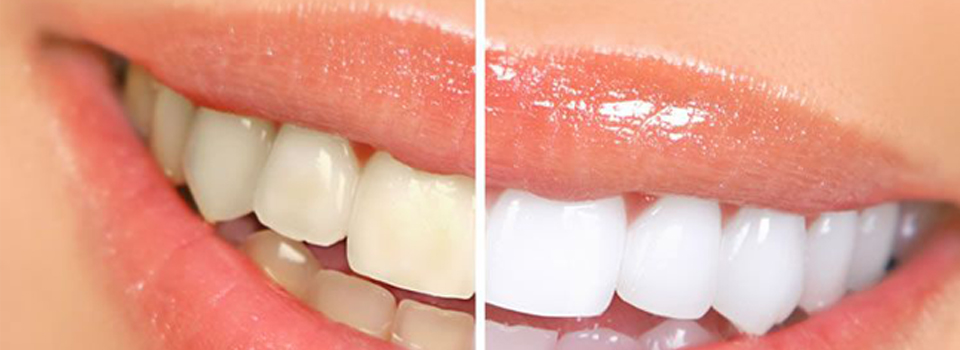All about teeth whitening – what you need to know!

Everything you ever wanted to know about whitening your teeth!
With a dizzying array of tooth whitening options on the market today, from products on your supermarket shelf such as toothpastes, home whitening kits and even tooth whitening dental floss, to professional-grade treatment such as from at-home tooth whitening kits, in-chair tooth whitening, and porcelain veneers, we thought it would be a good idea to chat with our dentist. We wanted to find out more: what’s safe, what works, what is healthy… and what might actually hurt!
A: Yes, most people can benefit from take-home tooth whitening kits, providing they have their natural teeth and don’t have any fillings or crowns on the front teeth. Also, if some of the front teeth have porcelain veneers, while the others don’t, you won’t get an even result. Only the teeth without the veneers will be bleached, so differences in the colour shade could appear.
A: Most of us! Anyone who drinks tea or coffee, which is a lot of us, will be mildly staining their teeth on an ongoing basis. Red wine drinkers can stand the teeth considerably, too, and, of course, those still smoking cigarettes now have another reason to give up! Nicotine stains are notorious for yellowing the teeth.
A: This is best answered on a case-by-case basis. I recommend you ask this question when you next see your dentist in a consultation. Generally speaking, a tooth whitening program at home is enough. Most people are very happy with the results and require no further treatment. If people want to try a tooth whitening kit though, the offer always includes a session with the dentist, which gives you the perfect opportunity to discuss the right tooth whitening treatment for you. Sometimes it’s simply a matter of personal choice. For example, you may have severely stained teeth and may receive a moderately pleasing result from home tooth whitening. If desired, there may be further tooth whitening options for you but you may decide this is enough.
A: Usually, tooth sensitivity is not a problem because as dental professionals, we prescribe the correct strength of whitening for your teeth. Some people may experience a touch of sensitivity, but to prevent this we provide all our patients with tooth mousse, which desensitises the teeth and alleviates this problem.
In the unlikely event that sensitivity is still a problem, you may choose to use your tooth whitening kit every second day instead of daily. Alternatively, we can always supply you with a weaker bleaching formula.
A: Individuals that are not candidates for tooth bleaching fall into two main categories: those with intrinsic staining, and those with prosthetic treatment modalities already on the teeth, such as crowns, fillings or veneers.
Intrinsic staining is staining from the inside out. Sometimes intrinsic staining comes from a developmental problem that may be genetically related. Other times it appears as a result of illness, such as being prescribed the tetracycline antibiotic. This caused blotchy, yellow-grey stains on many people’s teeth decades ago, and these stains would not be able to be removed through bleaching.
If you have crowns or veneers and they are stained, the only choice would be to replace them with new ones. Alternatively, you may need a couple more veneers to match up the colour with an existing crown. Once again, this is something best discussed with your dentist.
If you require a mixture of teeth whitening and porcelain veneers or crowns, it’s best that you perform the at-home tooth whitening first. Once the optimal level of whiteness is achieved, your dentist will then match this colour with your new porcelain veneers.
I might add that porcelain veneers also offer another benefit. For some individuals, stained teeth are only half their problem. They may have teeth that are chipped as well is stained. Or, they may have stains teeth that are ever so slightly out of alignment. Porcelain veneers are brilliant for correcting several problems at once. Not only can change the shade of your teeth, but while doing so can cover up any chips, ridges or slight alignment issues. This can result in straighter, whiter looking teeth that are free of chips or irregularities.
A: Basically speaking you would have to try and avoid drinking too much tea, coffee, red wine – and don’t smoke! Let’s just presume that if you are still smoking you are going to give up soon. Now, ideally, if you had to drink any of these stain-inducing beverages, it’s best to drink them through a straw – but I guess you’re going to laugh at me if I tell you to do that! Given that most of you would be a little embarrassed to be sipping red wine through a straw at your next dinner party, the best I can recommend is to rinse your mouth with water straight after drinking. And of course, now and then you might want to do a little more at-home tooth whitening to keep your teeth looking their best…
A: The percentage of bleach used in these flosses is about 1/10 of the strength that we would supply you with our professional grade whiteners. Also, because of the customised dental tray you will be given, the bleach will get right in between the teeth, eradicating the need for playing around with dental floss coated in dilute formulations of bleach. Of course, regular flossing with normal dental floss is imperative though, so this must always be a part of your daily dental hygiene routine.
A: In honesty, they won’t hurt your teeth, but they won’t provide you with any benefits either. I’d pay no attention to any claims of special whitening formulas or the likes. Just purchase a good toothpaste that contains fluoride.
A: You can’t whiten veneers in the same way that you can whiten natural teeth. Over 10 to 15 years there may be a small amount of staining on your porcelain veneers. For some this won’t be noticeable, but for others they may notice a small amount of staining over the margins (where the tooth meets the veneer). When this type of staining appears, a replacement is required. Fortunately though, you should enjoy plenty of years’ wear before you change them.


